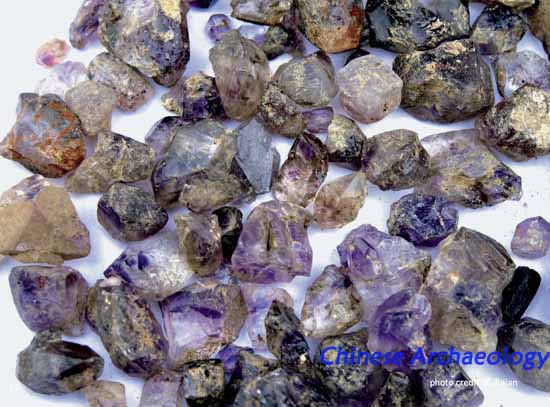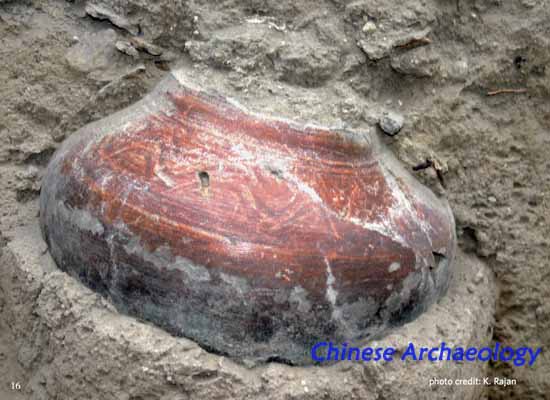Kodumanal: An Early Historic Industrial-cum-Trade Centre of South India
Kodumanal (11° 6’ 42” N; 77° 30’ 51”) in Perundurai Taluk, Erode District, Tamil Nadu State, India is located on the north bank of the east-flowing Noyyal, a tributary to the Kaveri. It is about 15 km west of Chennimalai, a famous weaving centre and about 40 km southwest of Erode. At present Kodumanal is a tiny, unassuming village. Agriculture in the locality consists of dry cultivation, dependent on monsoon rains supplemented by well irrigation. The raising of cattle and sheep is a concomitant feature, which more than supplements the meagre income from agriculture. However, its ancient significance is evident from the textual references to it as a trade-cum-industrial centre in Sangam literature Pdirruppattu (dated to the latter part of the first millennium BCE and the first millennium CE) as also from its location. The site lies on an ancient trade route that connects Karur, an ancient capital of Cheras, in the east to the seaport of Muciri on the west (present day Pattanam).
The antiquity of Kodumanal was first noticed by V. N. Srinivasa Desikan, ASI, as far back as 1961. After that early in 1980 a trial excavation was made on the site by the State Archaeology Department of Tamil Nadu whose results, however, have been reported only briefly by the Director of the Department, R. Nagaswamy. It is Pulavar S. Raju (formerly Professor of Epigraphy in Tamil University) who first brought out the real archaeological potential of the site by his frequent visits to the place.

This habitation-cum-burial site was excavated in seven seasons during the years 1985, 1986, 1989, 1990, 1997, 2012 and 2013. In total 63 trenches and 16 graves were opened in fifteen hectares of the habitation mound and forty hectares of the associated graveyard. The ongoing work there has revolutionized our understanding of the timing of the cultural transformation which constitutes the beginning of the early historical period in South India. This, in turn, will require reworking our paradigm for understanding the advent of the early historic for the Indian subcontinent as a whole.
It is generally believed that South India entered into the historical phase around c. 3rd c. BCE. This is because of the historical presence there of Emperor Ashoka of the Maurya dynasty (whose capital was located in Pataliputra on the Ganga river in the present state of Bihar) whose inscriptions mention political entities in the deep South. Since those epigraphs are found in the adjacent regions of Karnataka and Andhra, it has been argued that writing too was introduced into South India during his rule. Ashoka's epigraphs are in the Brahmi script, one of the two earliest writing systems of ancient India.

Kodumanal's excavations in recent years, however, have rendered that understanding as completely invalid. The site yielded five AMS dates of 200 BCE, 275 BCE, 300 BCE and 330 BCE and 408 BCE (all uncalibrated) for the samples collected from well stratified layers respectively at the depth of 15 cm, 60cm, 65cm, 80 cm 120 cm. These come from layers which have yielded a considerable number of potsherds bearing inscriptions in the Tamil-Brahmi script. The excavations have yielded more than 600 Tamil-Brahmi inscribed sherds. The names on these potsherds, in several instances, have affiliations with names from the North. The excavations have also yielded a couple of North Black Polished ware sherds which is associated with the first phase of the early historical period in North and Central India. In association with NBP, silver punch marked coins were found. There is now excellent evidence to argue that this commercial centre had well established trade and cultural contacts with the middle Gangetic plains in the 5th c BCE. Incidentally, there is still a 65 cm thick cultural deposit contained inscribed potsherds below the level that has yielded the above mentioned dates, so there is every possibility that the beginning of the early historic period may be pushed back further.

The other significant discovery made at the site was the exposure of a complete gemstone industry. Beads in different stages of manufacture, discarded chips, raw material blocks, a grooved stone slab form part of the extensive evidence unearthed from the central part of the habitation mound. The range of raw materials is also worth mentioning - sapphire, beryl, agate, carnelian, amethyst, lapis lazuli (which is likely to be from Badakshan), jasper, garnet and soapstone were unearthed from the habitation. Other significant findings were a crucible furnace used for manufacturing steel, iron furnace and copper smelting furnace. The evidence of textile production and a shell industry were found. The occurrence of various industries and trade items clearly suggest that Kodumanal was a flourishing trade-cum-industrial centre in South India during early historic times.
Taken together, the radiometric dates from Kodumanal make it crystal clear that the beginning of the early historic in South India - with writing, commercial centres marked by extensive artisanal activity, subcontinental trade with areas ranging from the Gangetic plains to Afghanistan - is a couple of centuries earlier than previously thought. Thus, the beginning of the historical period here has nothing to do with the empire and interests of the Mauryan emperor Ashoka.
K. Rajan (Pondicherry University)
Biographical sketch
K. Rajan, Professor at the Department of History, Pondicherry University. Professor Rajan is one of the noted archaeologists of South India who has done extensive archaeological explorations in different parts of India with much concentration in Tamil Nadu. So far, he has discovered more than 1500 archaeological sites ranging from palaeolithic times down to early historic phase. He has also actively participated in the archaeological excavations at Appukallu, Ramapuram, Bet Dwaraka and Kodumanal. Kodumanal has received a wide international attention. Professor Rajan has published 12 books and more than 75 scholarly articles. He is one of the team leaders of the Ford Foundation project “Historical Atlas of South India”. Professor Rajan is the recipient of Best Teacher Award, the Commonwealth and Charles Wallace Fellowships.

